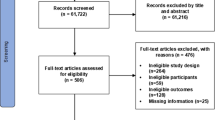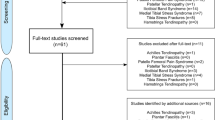Abstract
Novice runners, or non-runners starting to run, have an increased risk of developing a running-related injury, and have unique injury patterns compared to habitual runners. Identifying injury risk factors before and during training is useful in order for the clinician to advise novices on injury prevention. This article reviews the current body of literature on novice runners regarding anthropometrics, exercise and injury history, training protocol, biomechanics, and gait. Early trends that can guide clinical recommendations for the novice runner are reported, and areas for future research where current literature is inadequate are outlined.
Similar content being viewed by others
References
Papers of particular interest, published recently, have been highlighted as: • Of importance •• Of major importance
State of the Sport—Part II: Running Industry Report. 2014. At http://www.runningusa.org/2014-running-industry-report?returnTo=annual-reports. Accessed 15 Sept 14.
Fainaru-Wada M. CrossFit’s big growth fuels concerns. 2014. At http://espn.go.com/espn/otl/story/_/id/11262964/crossf-explosive-growth-fuels-safety-concerns. Accessed 21 Sept 14.
Brennan M. Obstacle course racers: the new marathoners. 2014. At http://www.cnbc.com/id/101856523. Accessed 21 Sept 14.
USA Triathlon Annual Membership Hits Record High in 2013. At http://www.usatriathlon.org/about-multisport/demographics.aspx. Accessed 21 Sept 14.
Chorley JN, Cianca JC, Divine JG, Hew TD. Baseline injury risk factors for runners starting a marathon training program. Clin J Sport Med Off J Can Acad Sport Med. 2002;12:18–23.
Macera CA, et al. Predicting lower-extremity injuries among habitual runners. Arch Intern Med. 1989;149:2565–8.
Buist I, Bredeweg SW, Lemmink KAPM, van Mechelen W, Diercks RL. Predictors of running-related injuries in novice runners enrolled in a systematic training program: a prospective cohort study. Am J Sports Med. 2010;38:273–80.
Buist I, et al. Incidence and risk factors of running-related injuries during preparation for a 4-mile recreational running event. Br J Sports Med. 2010;44:598–604.
Taunton JE, et al. A retrospective case-control analysis of 2002 running injuries. Br J Sports Med. 2002;36:95–101.
Nielsen RO, Rønnow L, Rasmussen S, Lind M. A prospective study on time to recovery in 254 injured novice runners. PLoS ONE. 2014;9:e99877.
Nielsen R, et al. Protocol for the dano-run study: a 1-year observational follow up study on running related injuries in 1000 novice runners. Br J Sports Med. 2011;45:365–6.
Bredeweg SW, Zijlstra S, Buist I. The GRONORUN 2 study: effectiveness of a preconditioning program on preventing running related injuries in novice runners. The design of a randomized controlled trial. BMC Musculoskelet Disord. 2010;11:196.
Buist I, et al. The GRONORUN study: is a graded training program for novice runners effective in preventing running related injuries? Design of a randomized controlled trial. BMC Musculoskelet Disord. 2007;8:24.
Malisoux L, Nielsen RO, Urhausen A, Theisen D. A step towards understanding the mechanisms of running-related injuries. J Sci Med Sport Sports Med Aust. 2014; doi:10.1016/j.jsams.2014.07.014.
Janney CA, Jakicic JM. The influence of exercise and BMI on injuries and illnesses in overweight and obese individuals: a randomized control trial. Int J Behav Nutr Phys Act. 2010;7:1.
Nielsen RO, et al. Predictors of running-related injuries among 930 novice runners: a 1-year prospective follow-up study. Orthop J Sports Med. 2013;1.
Buist I, Bredeweg SW. Higher risk of injury in overweight novice runners. Br J Sports Med. 2011;45:338.
Saragiotto BT, et al. What are the main risk factors for running-related injuries? Sports Med Auckl NZ. 2014;44:1153–63.
Czerniecki JM. Foot and ankle biomechanics in walking and running. A review. Am J Phys Med Rehabil. 1988;67:246–52.
Gast U, et al. Bone density and neuromuscular function in older competitive athletes depend on running distance. Osteoporos Int. 2013;24:2033–42.
Woo SL, Gomez MA, Woo YK, Akeson WH. Mechanical properties of tendons and ligaments. II. The relationships of immobilization and exercise on tissue remodeling. Biorheology. 1982;19:397–408.
Turner CH, Pavalko FM. Mechanotransduction and functional response of the skeleton to physical stress: the mechanisms and mechanics of bone adaptation. J Orthop Sci. 1998;3:346–55.
• Buist I, et al. No effect of a graded training program on the number of running-related injuries in novice runners: a randomized controlled trial. Am J Sports Med. 2008; 36: 33–9. This paper provides data showing no changes to injury risk when comparing traditional start to run programs using the 10 % rule to accelerated program that progresses distances more quickly.
Coffey VG, Hawley JA. The molecular bases of training adaptation. Sports Med Auckl NZ. 2007;37:737–63.
Hreljac A. Etiology, prevention, and early intervention of overuse injuries in runners: a biomechanical perspective. Phys Med Rehabil Clin N Am. 2005;16:651–67 vi.
Johnston CAM, Taunton JE, Lloyd-Smith DR, McKenzie DC. Preventing running injuries. Practical approach for family doctors. Can Fam Physician. 2003;49:1101–9.
•• Nielsen RO, et al. Excessive progression in weekly running distance and risk of running-related injuries: an association modified by type of injury. J Orthop Sports Phys Ther. 2014; 1–25. doi:10.2519/jospt.2014.5164. This paper suggests that novice runners can increase distances by up to 30 % in biweekly distances without significantly increasing injury risk.
Issurin VB. New horizons for the methodology and physiology of training periodization. Sports Med Auckl NZ. 2010;40:189–206.
• Bredeweg SW, Zijlstra S, Bessem B, Buist I. The effectiveness of a preconditioning programme on preventing running-related injuries in novice runners: a randomised controlled trial. Br J Sports Med. 2012; 46: 865–70. An axial load preconditioning program prior to run training was trialed, but did not succeed in lowering injury risk.
•• Nielsen RO, et al. Running more than three kilometers during the first week of a running regimen may be associated with increased risk of injury in obese novice runners. Int J Sports Phys Ther. 2014; 9: 338–45. Obese runners are at increased risk of injury, but this paper suggests that the obese runner can mitigate that risk by running less than 3 kilometers in the first week of training.
Vincent HK, Vincent KR. Considerations for initiating and progressing running programs in obese individuals. PM R. 2013;5:513–9.
Finnoff JT, et al. Hip strength and knee pain in high school runners: a prospective study. PM R. 2011;3:792–801.
Boling MC, et al. A prospective investigation of biomechanical risk factors for patellofemoral pain syndrome: the joint undertaking to monitor and prevent ACL injury (JUMP-ACL) cohort. Am J Sports Med. 2009;37:2108–16.
• Thijs Y, Pattyn E, Van Tiggelen D, Rombaut L, Witvrouw E. Is hip muscle weakness a predisposing factor for patellofemoral pain in female novice runners? A prospective study. Am J Sports Med. 2011; 39: 1877–82. Although isometric hip girdle strength is often tested clinically to diagnose biomechanical predispositions to injuries such as patellofemoral syndrome, this paper suggests that there may be minimal link between isometric hip girdle strength and running injury in female runners.
• Koblbauer IF, van Schooten KS, Verhagen EA, van Dieën JH. Kinematic changes during running-induced fatigue and relations with core endurance in novice runners. J Sci Med Sport Sports Med Aust. 2014; 17: 419–24. This paper suggests that fatigue may induce gait deviations that can then lead to running-related injury. Runners in the fatigued state are rarely assessed clinically.
Schmitz A, Russo K, Edwards L, Noehren B. Do novice runners have weak hips and bad running form? Gait Posture. 2014;40:82–6.
Lieberman DE, et al. Foot strike patterns and collision forces in habitually barefoot versus shod runners. Nature. 2010;463:531–5.
Larson P, et al. Foot strike patterns of recreational and sub-elite runners in a long-distance road race. J Sports Sci. 2011;29:1665–73.
Hasegawa H, Yamauchi T, Kraemer WJ. Foot strike patterns of runners at the 15-km point during an elite-level half marathon. J Strength Cond Res. 2007;21:888–93.
Bertelsen ML, Jensen JF, Nielsen MH, Nielsen RO, Rasmussen S. Footstrike patterns among novice runners wearing a conventional, neutral running shoe. Gait Posture. 2013;38:354–6.
Divert C, Mornieux G, Baur H, Mayer F, Belli A. Mechanical comparison of barefoot and shod running. Int J Sports Med. 2005;26:593–8.
McCarthy C, Fleming N, Donne B, Blanksby B. Barefoot running and hip kinematics: good news for the knee? Med Sci Sports Exerc. 2014. doi:10.1249/MSS.0000000000000505.
Kulmala J-P, Avela J, Pasanen K, Parkkari J. Forefoot strikers exhibit lower running-induced knee loading than rearfoot strikers. Med Sci Sports Exerc. 2013;45:2306–13.
Thijs Y, De Clercq D, Roosen P, Witvrouw E. Gait-related intrinsic risk factors for patellofemoral pain in novice recreational runners. Br J Sports Med. 2008;42:466–71.
Schubert AG, Kempf J, Heiderscheit BC. Influence of stride frequency and length on running mechanics: a systematic review. Sports Health. 2014;6:210–7.
Van Ginckel A, et al. Intrinsic gait-related risk factors for Achilles tendinopathy in novice runners: a prospective study. Gait Posture. 2009;29:387–91.
Ghani Zadeh Hesar N, et al. A prospective study on gait-related intrinsic risk factors for lower leg overuse injuries. Br J Sports Med. 2009;43:1057–61.
Keenan A-M, Redmond AC, Horton M, Conaghan PG, Tennant A. The foot posture index: Rasch analysis of a novel, foot-specific outcome measure. Arch Phys Med Rehabil. 2007;88:88–93.
Chuter VH. Relationships between foot type and dynamic rearfoot frontal plane motion. J Foot Ankle Res. 2010;3:9.
Nielsen RO, et al. Foot pronation is not associated with increased injury risk in novice runners wearing a neutral shoe: a 1-year prospective cohort study. Br J Sports Med. 2014;48:440–7.
Conflict of Interest
The authors declare that they have no conflict of interest.
Human and Animal Rights and Informed Consent
This article does not contain any studies with human or animal subjects performed by any of the authors.
Author information
Authors and Affiliations
Corresponding author
Additional information
This article is the part of the Topical collection on Sports Medicine Rehabilitation.
Rights and permissions
About this article
Cite this article
Gingrich, S., Harrast, M. Injury Prevention in Novice Runners: An Evidence-Based Approach and Literature Review. Curr Phys Med Rehabil Rep 3, 18–24 (2015). https://doi.org/10.1007/s40141-014-0075-9
Published:
Issue Date:
DOI: https://doi.org/10.1007/s40141-014-0075-9




